Brand-building ads boost short-term sales, and now you can prove it
Ten years since The Long and the Short of It was published, new evidence shows that while sales-driven ads deliver few long-term effects, brand advertising achieves both.

Everyone in marketing has heard about The Long and the Short of It (TLATSOI) and its authors Peter Field and Les Binet. But, as their grand theory reaches its 10th anniversary, the implications and applications of one of marketing’s most important ideas continue to evolve. As an early and enthusiastic fan, I’d like to detail the story so far and attempt to take it one step further down the road.
Step 1: Know the origins
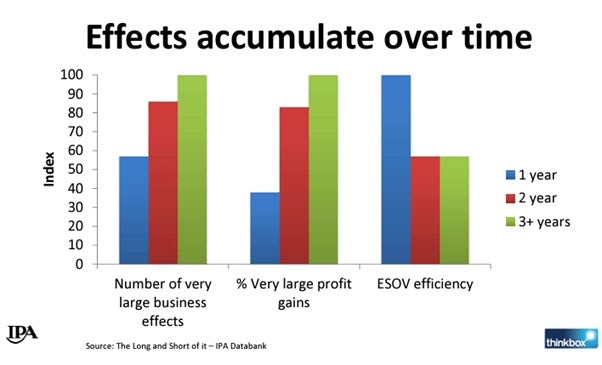 It’s a decade since Field and Binet plundered the IPA Databank to publish their famous monograph. The two authors had already established separate reputations in the industry. And they were already a well known duo thanks to their 2007 trailblazing study of advertising effectiveness, Marketing in the Era of Accountability, and 2010’s The Link Between Creativity and Effectiveness.
It’s a decade since Field and Binet plundered the IPA Databank to publish their famous monograph. The two authors had already established separate reputations in the industry. And they were already a well known duo thanks to their 2007 trailblazing study of advertising effectiveness, Marketing in the Era of Accountability, and 2010’s The Link Between Creativity and Effectiveness.
But TLATSOI was something different, something special. Field and Binet had begun to tease out the short-term flaws of marketing theory in earlier work, but the data had not been available to make any strong conclusions. Funding from Thinkbox and access to the IPA’s database of award submissions offered the duo a chance to properly examine the balance of long-term and short-term thinking.
The thinking behind TLATSOI was built from a database of just under 1,000 campaigns. Critics continue to suggest these award submissions represent a skewed sample and that the self-reporting format of much of the data nullifies any empirical validity. But despite these issues, the idea of ‘the long and the short’ struck a chord with marketers because it emerged at a very particular moment in the history of the discipline. The emergence and growth of new digital media formats was revolutionising much of marketing thinking. But along with some genuine advances and improvements, this digital turn also favoured a focus on shorter, almost immediate timelines.
There was an astonishing array of insights packed into TLATSOI. The primacy of TV, the value of mass marketing, the proper appreciation for excess share of voice, the importance of creativity, the impact of emotion – all of which were later to become big lessons for the decade ahead. But at the core of the long and the short were three incredibly basic, but inestimably important observations.
The long and the short of it, like everything in marketing, should be media-neutral.
First, that there were two connected but distinct approaches to communications. The long of it was all about the top of the funnel, a three-year-plus timeline and an emphasis on brand building. The short of it was more about the bottom of the funnel, a 12-month or shorter horizon and a focus on sales activation.
Second, that these two dimensions were both important to commercial success but had to be balanced in an appropriate manner to deliver the best results.
Finally, it was clear that since the start of the new millennium, too many organisations were adopting an approach that was too short term for their own commercial good.
Step 2: Know the difference
Once you know the back story, the most immediate challenge is to recognise what the long and the short look like ‘in the wild’. It’s a challenge that throws many marketers, who seem unable to discern what is long and what is short. Even the Dark Lord himself, Byron Sharp, confessed to confusion last year. “People have no idea,” he observed during a talk in Australia, “what activations really are and there’s no guidelines.”
There are guidelines, of course. If you care to look. They are blurry at the margins because, as we will see later, the long and short are not binary. Both, by definition, serve the same ultimate purpose. But they do so at two completely different speeds. Every brand beats with two different pulses.
The short of it, sales activation, is easier to identify. It’s anything that attempts to evoke an immediate response from the market. Visit our website. Buy our new burger. Test drive our latest car. Or, as in the ad below, purchase a sofa while it’s at this special, special price. These, and a million other claims, are exemplars of the short of it.
In contrast, the long of it is any communication that intends to create long-term memories, which might then result in enduring changes in human behaviour. Building awareness of our coffee brand with consumers who do not know us, yet. Driving consideration among consumers who don’t think our beer is for them, or for this occasion. Getting consumers to think our premium brand is premium.
These and many other objectives don’t ask for an immediate response and that might be the simplest way to identify them as the long of it. Instead, they look to set up the market in a manner that will later benefit the brand – especially if this longer-term brand advertising is complemented by the appropriate amount of shorter-term tactics further down the funnel, to activate these consumers later and engineer a sale. Here’s an example:
Many marketers confuse the long and short with tactical absolutes. They ask which media are superior for short activations and which ones are for long-term branding. This is the wrong approach. Because while some media suit one end of the sausage over the other a little more, any medium can serve either master, or both.
This issue comes up a lot when marketers shoe-horn digital media into an exclusively short-term tactical box. It does work well there. But there is no reason that digital media cannot also perform brilliantly as long-term brand-building tools too. The long and the short of it, like everything in marketing, should be media-neutral.
Step 3: Understand the bias
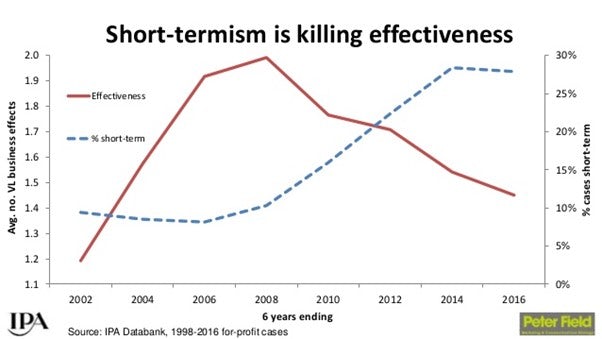 With all the effectiveness implications associated with TLATSOI, it is easy to forget that it originated with the identification of an emerging industry crisis. When TLATSOI was published in 2013, its foreword from the IPA’s Janet Hull described the “major threat” that short-term metrics were now having on the long-term profitability of brands. She worried that too many marketers were “sleepwalking towards a precipice”, totally unaware of a perilous shift away from longer-term brand building and towards an overweight approach to short-term activations.
With all the effectiveness implications associated with TLATSOI, it is easy to forget that it originated with the identification of an emerging industry crisis. When TLATSOI was published in 2013, its foreword from the IPA’s Janet Hull described the “major threat” that short-term metrics were now having on the long-term profitability of brands. She worried that too many marketers were “sleepwalking towards a precipice”, totally unaware of a perilous shift away from longer-term brand building and towards an overweight approach to short-term activations.
This wasn’t hyperbole, either. I remember the Advertising Council, the equivalent of the IPA Down Under, announcing at its annual prizegiving a few years later that it would not award a gong for best long-term effectiveness campaign, because none of the submissions that year had been particularly effective or especially long-term enough to justify the prize.
Why was this? Why did marketers swing so short? It was a function of three main forces.
First, the phalanx of new, exciting digital suppliers pushed their ROI credentials and in so doing pulled clients towards shorter-term horizons. Second, an emphasis on proving the value of advertising and marketing squeezed many marketers towards more immediate and easier-to-measure sales spikes – the kind usually delivered by shorter-term activation campaigns. Third, that same trend worked in reverse to reduce investment in longer-term brand-building efforts that demanded more advanced statistical skills and seasoned marketing knowledge to justify them.
The incremental nature of long-term brand building campaigns was meant to be their strength, but in the increasingly short-term world of marketing it became their downfall. It took time for brand campaigns to be developed and then fully deliver on any sales impact, and that was simply not something that most marketers could justify or deliver.
By going short, most marketers did make more money in the upcoming year, but most also started to lose potential profit in year two and onwards. But their effectiveness myopia obscured them from seeing this tragic state of affairs and wedded them to making the same mistake every year that followed.
The greatest management thinker of them all, Peter Drucker, explained all of this 60 years before the publication of TLATSOI. “You have to produce results in the short term,” he wrote in The Practice of Management. “But you also have to produce results in the long term. And the long term is not simply the adding up of short terms.”
Too many marketers were taking a 12-month, or shorter, horizon and sailing their ships in a sub-optimal direction as a result. The great irony of this focus on ROI was that, having adopted a shorter-term approach, almost all of the marketers that did so ultimately destroyed much of the profit potential of their brands.
‘Marketers need to get real’: Addressing the significance of ROI
Step 4: Appreciate the harmony
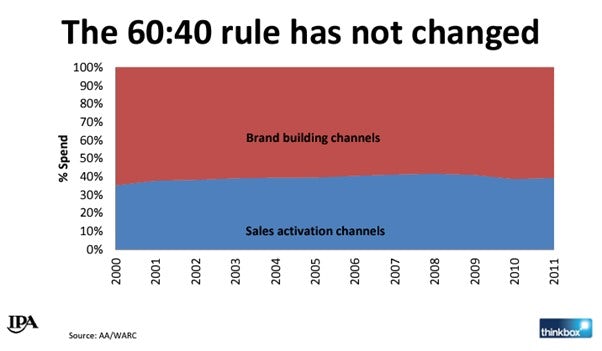 One of the most important gifts that TLATSOI bestowed upon marketers was not only a warning of the impending threat of short-termism but also the provision of a potential solution. By assessing which campaigns from their data set had performed optimally in both achieving long, short and overall commercial success, Field and Binet were able to propose an optimum balance of long and short investment. A brand spending 60% of its communications budget on long-term brand building and the remaining 40% on shorter-term activations would be more likely to prosper, they claimed in 2012.
One of the most important gifts that TLATSOI bestowed upon marketers was not only a warning of the impending threat of short-termism but also the provision of a potential solution. By assessing which campaigns from their data set had performed optimally in both achieving long, short and overall commercial success, Field and Binet were able to propose an optimum balance of long and short investment. A brand spending 60% of its communications budget on long-term brand building and the remaining 40% on shorter-term activations would be more likely to prosper, they claimed in 2012.
That metric became initially more famous than the title of the book that contained it. For the first few years of the last decade, Field and Binet were more commonly associated with the ’60:40 rule’ than anything else. This was unfortunate. Because, although the 60:40 precept was broadly applicable, it was a crude average made up of many different categories, brands and strategic situations. Correct in general but askew in most specific situations, that 60:40 average was later broken into more granular advice that depended on contextual factors like brand size, maturity, category and a host of other factors.
These days, most trained brand managers are aware of these sensitivities, while most untrained ones rail against the generic 60:40 balance as being too generic and prescriptive – which of course it is. But the advantage and attraction of this oversimplistic ratio is that it provided marketers with a priori guidance towards what a good long-term brand-building investment should look like for their brand. Many did not reach those heady levels, but it became a lighthouse that pulled extraordinary numbers of brands away from the siren song of short-term overinvestment.
Step 5: Avoid double duty
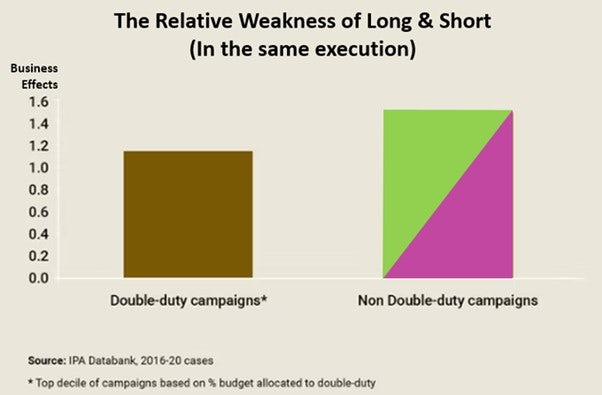 Ritson’s Law, which I just made up at the beginning of this sentence, stipulates that any popular marketing concept will be criticised in direct proportion to the degree to which marketers don’t understand it. Those without an MBA or any actual knowledge of what constitutes one are full of arguments why it is worthless. Most marketers have a problem with the 4Ps without knowing what the four are or how they are meant to be applied.
Ritson’s Law, which I just made up at the beginning of this sentence, stipulates that any popular marketing concept will be criticised in direct proportion to the degree to which marketers don’t understand it. Those without an MBA or any actual knowledge of what constitutes one are full of arguments why it is worthless. Most marketers have a problem with the 4Ps without knowing what the four are or how they are meant to be applied.
Meanwhile, we leap onto the simplistic, tosh-laden greeting-card nonsense of Simon Sinek with mindless abandon, not because it’s true but because it’s so simple my beagle could grasp it. Marketers turned on the empirical mastery of Field and Binet because of its rich complexity and an inability to grasp the idea that TLATSOI, like segmentation or the sales funnel, is a metaphor to guide good marketing and not a reality in and of itself.
As TLATSOI became more accepted, more discussed and more misunderstood, a common critique emerged, especially from an old guard who regarded any new theory as an unnecessary overdecoration to their functioning extant model. Specifically, the criticism centred on whether the separation of advertising into long and short executions was preferable, or even possible.
I remember, critics would huff and puff, when you could build brand and sell widgets in a single ad. Without any of this unnecessary separation or complexity. Keep it simple! David Ogilvy, etc, etc.
To put it the other way: short-term campaigns don’t build brand, because they are too good at product-based activation.
There was an element of truth in this criticism, stemming from the grey margins of the two sides of the long and the short. Run the most brand-centric, long-term, top-of-funnel, emotional cinema ad to build brand image and someone, somewhere will walk out of the theatre and immediately seek out your widget. Long still drives some short.
Similarly, while you might devise the most product-based, promotionally focused bottom-of-funnel activation possible to sell your dingus before midnight on Friday, the very presence of the ad and the mention of the brand will likely have some modicum of enduring, top-of-funnel impact on at least one consumer, who does not buy yet but remembers your brand into the future. Short can also drive long.
There are no absolutes in a continuum after all. And marketers could and did run ads that attempted to satisfy both short- and long-term objectives within the same 30 seconds. And it sometimes worked.
Can you achieve long and short at the same time? Usually, no
But the chance of these ‘double-duty’ ads, as Peter Field calls them, working – and working better than a campaign consisting of different long and short executions – was not zero, but it was small. And that should not be a surprise.
In a mistake that only a decade could have revealed, calling this organising theory The Long and the Short of It misled marketers into thinking that it was only the time frame of the two approaches that was different. In truth, it was much, much bigger than that. The long is about brand, TOFU, mass market, emotion. The short is about targeted, rational, BOFU, product messaging. It’s very hard to straddle these paradigmatic differences in a successful ad too many times.
Statistically speaking, you are better off taking your advertising budget, dividing it into the two pots according to the appropriate balance, and then achieving long and short objectives with different ads – ads that are only eventually united within your overall annual brand campaign. Long was then free to set up short. Short could then close the deal and fund more long (and short) advertising. A wonderful brand-building wheel could begin to turn, and keep turning with ever increasing circumference.
Step 6: Learn about the asymmetry of long and short effects
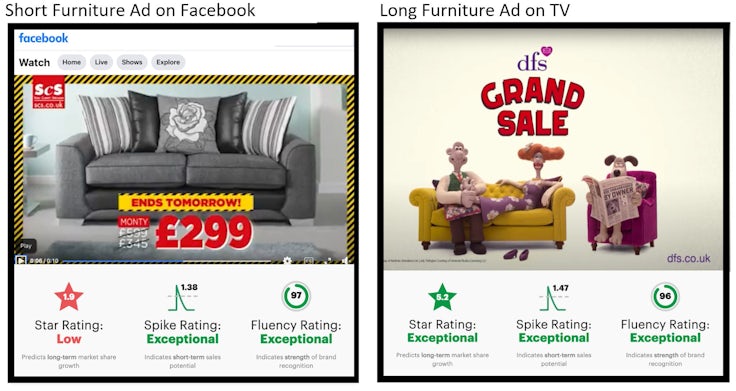
But there is a wrinkle in the long and the short that has only recently emerged, thanks to the ad tracking work of research firm System1. Its near real-time database of almost 18,000 ads measured over the past four years adds a final twist to the five chapters that precede it.
The original interpretation of double-duty ads and their failure to do as well as long, brand-building ads and separate, short, activation ads suggested a symmetry in which long-term advertising just does brand building and short-term activation advertising just does sales. The greyness of the long and the short meant there was likely to be a little bit of overspill, as noted above, but not that much.
And that’s certainly true when you look at ads that deliver on short-term activation, according to System1. It tests every ad with a representative sample of the audience to generate both a short-term ‘spike rating’ and a longer-term ‘star rating’. The classically short SCS ad above, for example, scores well in both its ability to drive short-term sales and its fluency – the degree to which the ad is attributed to the brand. But, as might be expected, it fails miserably to do any long-term brand building on behalf of SCS. No shame there, that was not the objective and – if I had to bet – the company enjoyed a significant return on its promotional campaign.
The short does not deliver the long
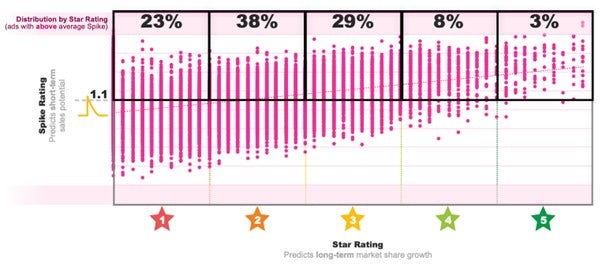
And that is a story we see played out consistently across most ads aimed at delivering short-term activation. In the chart above you can see the SCS ad along with more than 18,000 others (the little pink dots) distributed vertically up and down the Y-axis measure of their short-term spike rating and horizontally across the X-axis measure of their long-term star rating.
The ads performing above a 1.1 spike rating (in the top half of the chart) are deemed above average in their potential to drive short-term sales. But look at their horizontal location, which indicates their long-term brand building capabilities. If long and short were possible within the same ad, to the same degree as separate long and short ads, we would expect to see an even distribution of good short-term campaigns across each of the stages of the star rating. Or about 20% of the above-average spike-rated campaigns in each of the star rating boxes along the top.
But we don’t see that. Ads that perform well at short-term activation are conspicuously shithouse, for the most part, at building brand over the long term. By the time we reach the outstanding brand-building and long-term effects of ads with a star rating of 4 or 5, the proportion of campaigns delivering an above-average short-term spike rating has fallen to single digits.
To put it the other way: short-term campaigns don’t build brand, because they are too good at product-based activation. Indeed, as the chart above shows, the better they are at shorter activation, the less likely they are to be good at brand building. It’s a perfect explanation for the double-duty deficit shown earlier.
But, in a discovery that I must credit to System1’s marketing director Nick Williamson, the same cannot be said for long-term brand building ads. If things were to stay neat and symmetrical, we would see a similar story, where good brand-building ads fail miserably to do the short of it with any kind of consistent success. But there are many cases where an ad that builds the brand for the long term also drives short term sales.
The classic long ad for DFS we looked at earlier performs very well on its star rating and fluency, but it also delivers exceptional short-term sales potential too. And it’s not an outlier as you can see below.
The long does deliver the short
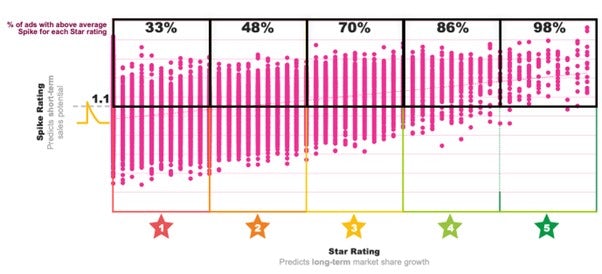
When we review the 18,000 ads according to brand-building potential, from a star rating of 1 (poor long-term market-share growth) to 5 (outstanding) we see a different relationship between long and short. As an ad gets better at the long of it (achieving a greater star rating), it also gets better – on average – at delivering the short of it too (a higher spike rating).
This relationship is significant. Not only is it possible for long-term brand building ads to also deliver short-term sales activation, we can conclude that the better an ad is at brand building, the more likely it becomes that it will also deliver on short-term sales too. We can refer to this, if Pete and Les allow it, as the ‘asymmetry of long and short effects’. The short of it, for the most part, does little for long-term brand building in most cases. But the long of it delivers on both fronts. And the implication for marketers is doubly significant.
First, we can reframe the risk of short-termism in even clearer terms. Marketers should continue to invest in short-term sales activation because it shifts more units, usually with splendid efficiency and ROI. For those reasons, the short of it will always have a place in every marketer’s armoury. But the danger of overinvesting or only investing in short-term tactical activation now becomes all the more apparent, given the general inability of this kind of advertising investment to build brand for future sales. It leaves the brand at risk of ever-decreasing circles of demand while mopping up the current in-market potential.
In contrast, the case for brand building is now strengthened further. Partly because the harmonious growth of any brand depends on the right balance of long and short investments. Partly because in most contexts the optimal budget allocation usually favours more spend on brand building than short-term activation. But also because long-term ads can also have a significant short-term impact too.
It’s a stunning discovery because it should reverse the perception of long-term brand building, which has too often been seen as a frivolous, underperforming indulgence offering up zero short-term impact and questionable longer-term returns. Nothing – it turns out – could have been further from the truth. Long-term brand building is the ultimate strategic BOGOF, ensuring shorter-term impact as well as longer-term benefits.
“CFOs are often wary of the word ‘long’, with the potential perceived implication of waiting months or even years for a financial return on the ad investment,” Nick Williamson put it to me this week. “But our data shows that, in nine out of 10 cases when an ad delivers a strong brand-building effect, it will also be successful at driving short-term sales. When seeking sign-off for budgets, CMOs might increase their chances of success by framing their proposed campaigns as ‘lasting’ rather than ‘long’.”
There is a change in the air among big brands as 2023 begins. Yes, there are recessionary headwinds but it does seem that the context is swinging more favourably toward longer-term brand building, after a dangerous decade-long flirtation with short-termism. Perhaps the asymmetries of long and short, combined with all the existing implications of the marvellous work of Field and Binet, will further extend this rebalancing of budgets and activity as the year progresses.
Has an era of long-term brand building begun?








Fantastic article Mark. Thank you